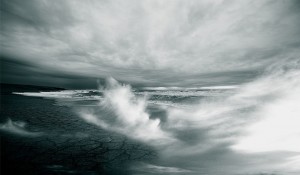Therapy as a “Creative Storm”
“So do you have experience with this?”
Quite a few people who want to begin therapy ask me this. Of course, this is a perfectly reasonable question, but I still usually find myself searching for a good response. The answer should be easy. My specialization as a therapist is the treatment of anxiety and my subspecialty is OCD therapy. Many people, therefore, contact me because they are struggling with one of these issues or both. Of course, I have experience as well as training and skills working with people on these matters, so I could just say “Yes” with confidence and conviction.
It took me a bit to get to the bottom of my own hesitation, but eventually I realized where it stemmed from. Stating I had experience with the specific problem of the person in front of me takes me away from the mental and emotional space I am in whenever I meet a new person who wants to begin therapy. When I recently came across the book The Storm of Creativity by Kyna Leski and John Maeda I found my conundrum addressed beautifully.

The authors explain the main elements of the process of creativity via the analogy to an actual storm. There is no strictly defined sequence of these elements. However, when venturing into a new creative endeavor there is the phase of “letting go of preconceptions and unlearning what we believe we know.” I realized that this is the state of mind I find myself in when beginning therapy work with somebody. The person knows so much more about themselves and the questions that bring them to therapy than I will ever be able to comprehend. Claiming I have experience with what troubles them seems like a gross imposition and a clear breach of the humility I need to feel and embody in order to foster a therapy experience that can feel safe and supportive. Ideally, this can also allow the person engaging in the creative path of therapy to let go of preconceptions about themselves that hold them back and to unlearn things that make them suffer.
In The Storm of Creativity, the authors state that every new human endeavor really is a creative process. The elements they lay out struck me as wonderful descriptions of the process of therapy.
There is the element of “defining the problem.” What is it that I want to figure out? This can seem pretty straight forward in the beginning of therapy. “I have an anger issue so I thought I should go to see somebody.” I have heard this statement often from people who appeared really not angry at all. When exploring the problem it turned out that they started to yell when overwhelmed by a conflict which seemed irresolvable. After realizing this, we now had quite a different problem to approach creatively.
Then there is the element of “gathering and tracking.” This involves identifying what it may take to begin to feel better and how to actually know that this is happening. This is where perhaps some of my experience with certain therapy approaches can come in, where I can make suggestions or ask questions that can support the person in rediscovering their own strengths and resources and experiment with what works for them. If we look at the experience of intense physical anxiety this could mean looking at: When does it happen? How does it feel exactly? What thoughts may fuel it? What fuels these thoughts? And what happens when I let the anxiety rise and fall without trying to make it go away?
Perhaps my favorite element of the “creative storm” is what the authors call “remembering the future.” This is the aspect of creativity that involves intuition, insight, and imagination. All of these faculties are active when we remember something and they also are at the core of the creative process. Realizing how these mental activities are related can also explain a “Eureka moment.” It may seem that we have come across something completely new but it also strangely appears as if we have known it all along. It is what happened to me when I realized what was behind my discomfort with the “experience question.” It is also fundamentally what the therapy process can bring forth. While we are remembering and exploring our inner workings we gather insight into ourselves and our potential for growth and change. This is guided by our intuition, a more subconscious knowing and drive. Both of these foster our imagination of what is possible and where we want to go, which in turn lights the beacons along the path we can follow toward an experience of life that is fulfilling and aligned with our values and goals.
Finally, an element of the creative process which is not often discussed is “the pause.” It can be so difficult for us to “sit with a problem,” to hold still until the time is right to move again. We tend to feel stuck when things don’t change for a while. As a therapist I also don’t find it easy to know what is a pause, what is an “iteration” (another element of the creative process) where we may be discussing and weighing the same problem many times in slightly shifting and fundamentally creative ways, and when has movement seized and we may have to shake things up more thoroughly and unlearn and gather again. But then life is never truly “stuck.” There is always movement and change and if there is one task I truly believe I have as a therapist it is to hold and highlight this reality and keep the creative storm churning.
